The Automotive Exhaust Headers Market is estimated to be valued at USD 5.0 billion in 2025 and is projected to reach USD 9.4 billion by 2035, registering a compound annual growth rate (CAGR) of 6.5% over the forecast period.
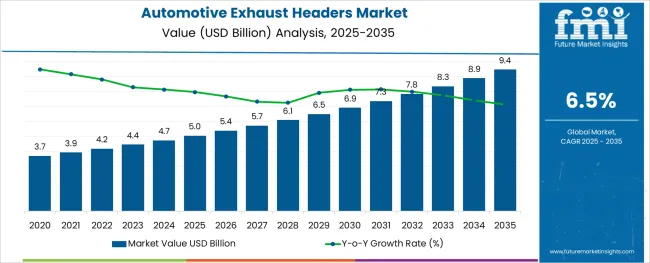
The automotive exhaust headers market is witnessing steady growth due to rising demand for performance enhancement, emission control, and fuel efficiency optimization across automotive segments. With increasing regulatory scrutiny on vehicle emissions and a parallel rise in consumer interest for aftermarket performance parts, manufacturers are integrating advanced exhaust header solutions to maximize engine output.
Technological advancements in mandrel bending, welding precision, and thermal resistance have contributed to enhanced airflow efficiency and reduced backpressure in engine systems. Original equipment manufacturers and aftermarket players alike are focusing on improving material durability and heat management while ensuring compliance with evolving emission standards.
The future outlook remains favorable as both sports and utility vehicle markets adopt high efficiency exhaust headers to improve torque, horsepower, and environmental performance.
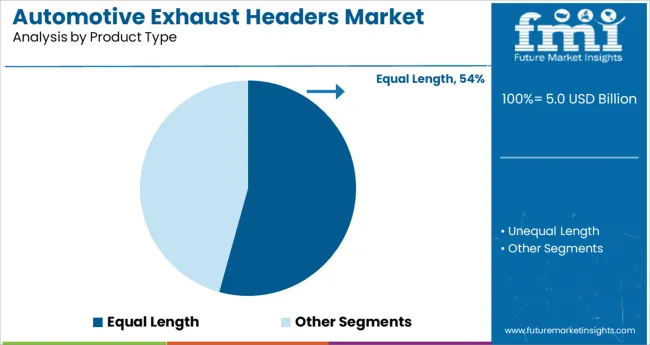
The equal length product type segment is projected to represent 54.30 percent of total market revenue by 2025, making it the leading product configuration. This dominance is driven by its proven capability to optimize exhaust pulse timing, reduce cylinder scavenging losses, and enhance engine breathing efficiency.
Equal length headers ensure that exhaust gases from each cylinder reach the collector simultaneously, thereby minimizing turbulence and improving power output across the RPM range. Their widespread adoption in high performance and racing applications has further fueled demand.
As automakers and performance tuning enthusiasts seek consistent engine response and smoother torque curves, equal length headers continue to be the preferred solution for enhancing combustion balance and overall engine efficiency.
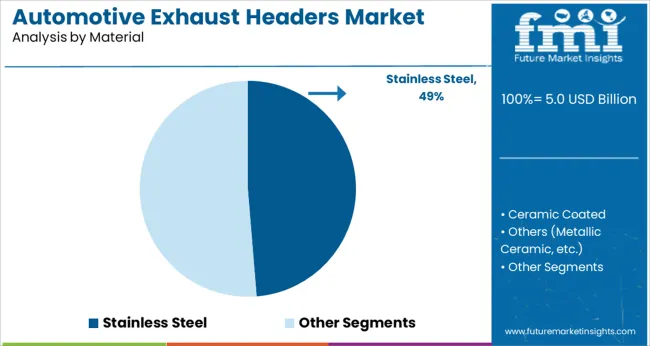
The stainless steel segment is expected to account for 48.70 percent of total revenue by 2025 within the material category, positioning it as the leading material type. This growth is attributed to the material’s superior resistance to corrosion, high heat tolerance, and structural integrity under extreme operating conditions.
Stainless steel exhaust headers offer extended product lifespan, improved reliability, and low maintenance compared to alternative materials such as mild steel or coated alloys. Its adaptability to both OEM and custom fabrication requirements has also supported broader market adoption.
In environments where temperature extremes and exposure to moisture or road salts are prevalent, stainless steel remains the material of choice due to its ability to maintain performance and appearance over time.
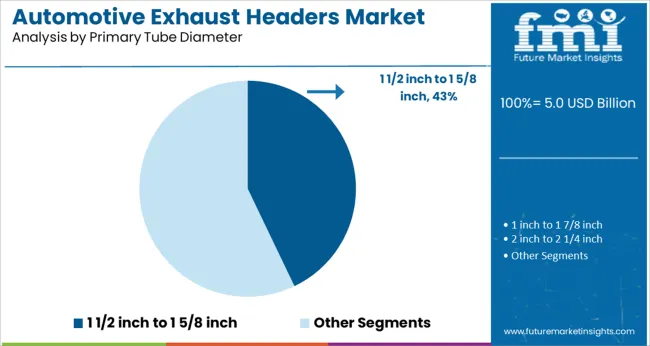
The primary tube diameter range of 11/2 inch to 15/8 inch is projected to hold 42.90 percent of total revenue by 2025, making it the dominant specification within this category. This range is preferred for small to mid displacement engines where maintaining optimal exhaust velocity is critical for achieving low to mid range torque gains.
The sizing balance ensures adequate backpressure reduction without compromising scavenging efficiency. It is widely compatible with a range of engine platforms, making it a standard choice for both factory upgrades and aftermarket performance kits.
The segment’s prominence is further supported by its ease of installation, cost effectiveness, and proven effectiveness in street performance and light track applications.
The analysis of the Automotive Exhaust Headers Market estimates its value at USD 2,084.6 Million in 2025 and reveals a historical growth rate of less than 1.4% CAGR for the period of 2020 to 2024.
The COVID-19 pandemic crisis has impeded the global expansion of the auto sector as well as many other businesses. The majority of businesses worldwide have suffered as a result of the worldwide lockdown that was imposed and made people stay at home. Vehicle sales were impacted by the imposed lockdown, which in turn led to a decline in the global automotive exhaust headers market.
However, it is anticipated that the global market for automotive Exhaust Headers market will grow beginning in 2024 due to end users' preferences for using personal vehicles more frequently than public transportation, which fuels the global automotive market. As a result of this, FMI’s automotive pressure plate market demand projection predicts a CAGR of 6.5% by 2035.
In the coming years, it is projected that the market for Automotive exhaust headers would develop due to the strict regulatory constraints and rising producer investment in R&D for effective exhaust systems. The market is also expected to grow in the upcoming years as a result of the rising automobile industry in developing nations.
Additionally, it is predicted that increased automotive production, improvements in automotive catalysts, and technical collaborations between OEMs and Tier I companies will assist the business in the years to come. Some constraints and challenges can be impede the industry from growing.
Headers are one of the simplest bolt-on accessories for improving engine performance. The purpose of headers is to help the engine push exhaust out of the cylinders more easily. Exhaust headers boost performance by reducing exhaust limitations and facilitating scavenging. You'll find them on race cars and hot rods, with a short modification.
The massive increase of automobile particulate filters is largely due to concerns about rising carbon emission regulations, which has spurred several regional and worldwide level policies to minimise the same. Businesses are employing tactics such selective catalyst reduction to improve the performance of particulate filters.
The market for automotive Exhaust Headers is directly impacted by auto manufacturing levels. leading to the production of passenger cars and commercial trucks is increasing in both emerging and developed nations, which is driving the global market for engine exhaust projects.
The worldwide automotive industry is experiencing a development in the integration of automotive electronics, the use of advanced materials, and the use of advanced technologies and processes in automobiles, development, and manufacturing.
Due to the greater adoption of these changes, modern automobiles are safe, greater energy-efficient, and fuel-efficient. However, such worldwide automotive sector changes have led to a rise in automobile prices. Exhaust system components such as catalytic converters, mufflers, and others vary in price depending on the vehicle.
This is because current automotive catalytic converters now use metals such as rhodium, platinum, and palladium. The price of these metals is rising, which raises the total cost of a exhaust system. Furthermore, the rising usage of 3 catalytic converters and improved selective catalytic (SCR) raises the overall cost of current exhaust systems.
The demand for electric vehicles is increasing as more people become aware of the negative environmental effects of automotive pollution. A increasing international acceptability of powered mobility is also projected as a result of government tax and subsidy exemption policies in the coming years, which is expected to limit the market growth for engine exhaust Headers in European countries.
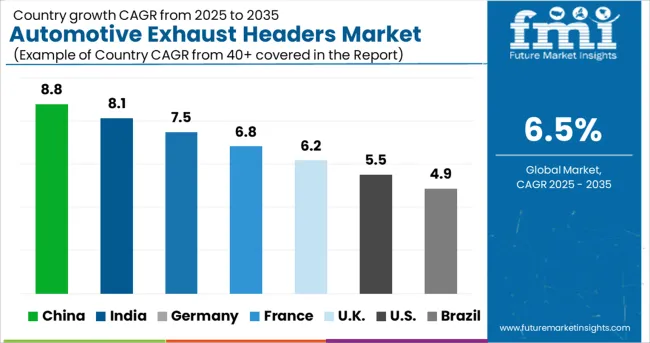
A large portion of the automotive exhaust headers market is anticipated to be dominated by East Asia, followed by Europe, due to the existing fleet and rising leisure activities in each area. As production operations in East Asia and South Asia are creating income prospects in the aforementioned regions, the majority of automotive and component production is centred in those two continents.
The market for automotive exhaust headers is expected to increase significantly in South Asia, then East Asia. In recent years, automakers have built production plants in Morocco, Algeria, and the United Arab Emirates, which are expected to become emerging markets for automotive exhaust headers in the coming ten years.
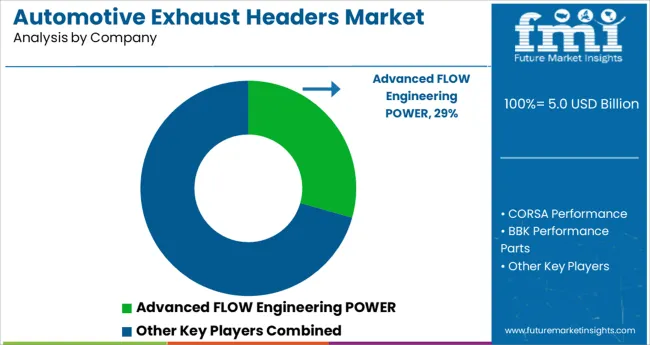
Key players operating in the Automotive Exhaust Headers market include Holley Performance Products, advanced FLOW engineering POWER, CORSA Performance, BBK Performance parts, Doug Thorley Header, BORLA PERFORMANCE INDUSTRIES, AUTOSALES, INCORPORATED, Schoenfeld Headers, JBA Headers, Speedtech Performance USA, LLC, PaceSetter Manufacturing Inc., Kooks Headers., PerTronix Inc, Racing Power Company., Drake Automotive Group.
| Attribute | Details |
|---|---|
| Growth Rate | CAGR of 6.5% from 2025 to 2035 |
| Base Year for Estimation | 2024 |
| Historical Data | 2020 to 2024 |
| Forecast Period | 2025 to 2035 |
| Quantitative Units | Revenue in million, Volume in Units and CAGR from 2025 to 2035 |
| Report Coverage | Revenue Forecast, Volume Forecast, Company Ranking, Competitive Landscape, Growth Factors, Trends and Pricing Analysis |
| Segments Covered |
Product Type, Materials, Primary Tube Diameter, Sales Channel, Vehicle Type |
| Regions Covered |
North America; Latin America; Europe; East Asia; South Asia & Pacific; Middle East and Africa |
| Key Countries Covered |
USA, Canada, Mexico, Brazil, Germany, Italy, France, UK, Spain, Benelux, Russia, China, Japan, South Korea, India, ASEAN, ANZ, GCC Countries, Turkey, South Africa, North Africa |
| Key Companies Profiled |
Holley Performance Products; advanced FLOW engineering POWER; CORSA Performance; BBK Performance parts; Doug Thorley Header; BORLA PERFORMANCE INDUSTRIES; AUTOSALES, INCORPORATED; Schoenfeld Headers; JBA Headers; Speedtech Performance USA, LLC; PaceSetter Manufacturing Inc..; Kooks Headers.; PerTronix Inc; Racing Power Company.; Drake Automotive Group |
| Customization & Pricing | Available upon Request |
The global automotive exhaust headers market is estimated to be valued at USD 5.0 billion in 2025.
It is projected to reach USD 9.4 billion by 2035.
The market is expected to grow at a 6.5% CAGR between 2025 and 2035.
The key product types are equal length and unequal length.
stainless steel segment is expected to dominate with a 48.7% industry share in 2025.






Full Research Suite comprises of:
Market outlook & trends analysis
Interviews & case studies
Strategic recommendations
Vendor profiles & capabilities analysis
5-year forecasts
8 regions and 60+ country-level data splits
Market segment data splits
12 months of continuous data updates
DELIVERED AS:
PDF EXCEL ONLINE
Automotive Carbon Ceramic Brake Market Size and Share Forecast Outlook 2025 to 2035
Automotive Camshaft Market Size and Share Forecast Outlook 2025 to 2035
Automotive Stamping Industry Analysis in India Size and Share Forecast Outlook 2025 to 2035
Automotive Cylinder Liner Market Size and Share Forecast Outlook 2025 to 2035
Automotive Microcontroller Market Size and Share Forecast Outlook 2025 to 2035
Automotive Roof Rails Market Size and Share Forecast Outlook 2025 to 2035
Automotive Active Safety System Market Size and Share Forecast Outlook 2025 to 2035
Automotive Diagnostic Scan Tool Market Size and Share Forecast Outlook 2025 to 2035
Automotive Test Equipment Market Size and Share Forecast Outlook 2025 to 2035
Automotive Dynamic Map Data Market Size and Share Forecast Outlook 2025 to 2035
Automotive Green Tires Market Size and Share Forecast Outlook 2025 to 2035
Automotive E-Tailing Market Size and Share Forecast Outlook 2025 to 2035
Automotive Interior Market Forecast Outlook 2025 to 2035
Automotive Key Market Size and Share Forecast Outlook 2025 to 2035
Automotive Appearance Chemical Market Forecast and Outlook 2025 to 2035
Automotive Seating Market Forecast and Outlook 2025 to 2035
Automotive Domain Control Module Market Forecast and Outlook 2025 to 2035
Automotive Remote Diagnostic Market Forecast and Outlook 2025 to 2035
Automotive-grade Inertial Navigation System Market Size and Share Forecast Outlook 2025 to 2035
Automotive Thin IGBT Module Market Size and Share Forecast Outlook 2025 to 2035

Thank you!
You will receive an email from our Business Development Manager. Please be sure to check your SPAM/JUNK folder too.
Chat With
MaRIA